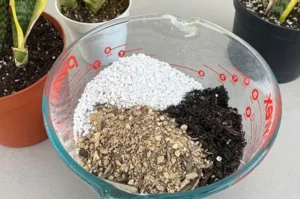Snake plants are loved for their hardiness and stylish, upright leaves. But even though plants have preferences, especially when it comes to water quality. If you’ve been watering your snake plant with tap water, you might be wondering: Is it the best choice? Or should you switch to distilled or reverse osmosis (RO) water?
In this article, we’ll dive deep into the differences between RO, distilled, and tap water and explore which is best for your snake plant’s health and growth. Whether you’re a plant parent or a gardening enthusiast, this guide will help you make the right watering decision and potentially improve your plant’s lifespan.
Why Water Quality Matters for Snake Plants
Water isn’t just water, at least not for plants. The type of water you use can impact the health of your snake plant’s roots, soil pH, and even how well it absorbs nutrients.
Snake plants are sensitive to salt buildup, chlorine, fluoride, and hard minerals found in regular tap water. Over time, these elements can accumulate in the soil and damage the roots, leading to leaf discoloration, root rot, or stunted growth.
Tap Water: Convenient but Risky
Pros:
- Easy to access: Just turn on the faucet.
- Low cost: No extra expense involved.
- May contain minerals: Some beneficial minerals like calcium and magnesium, can support plant health in small amounts.
Cons:
- Contains chlorine and fluoride: These chemicals can harm the roots and cause leaf tips to brown.
- Hard water risk: High levels of calcium or magnesium (common in hard water areas) can cause salt buildup in soil.
- Unpredictable pH: Tap water’s pH level varies by location, affecting nutrient uptake.
Bottom line: If you must use tap water, let it sit out for 24–48 hours before watering. This allows chlorine to evaporate, but fluoride and other minerals will remain.
Distilled Water: Pure But Lacking
Distilled water is created by boiling water into steam and then condensing it back into liquid form, removing all impurities, including minerals and chemicals.
Pros:
- Completely pure: No salts, chlorine, or contaminants.
- Safe for sensitive plants: Won’t cause chemical buildup in soil.
- Consistent quality: No fluctuations in mineral content or pH.
Cons:
- No minerals: Lacks calcium, magnesium, or other natural trace nutrients.
- Can cause deficiencies: Long-term use may lead to a lack of micronutrients unless you fertilize properly.
- Less sustainable: Distillation uses energy and may be wasteful in large quantities.
Bottom line: Distilled water is safe for snake plants but should be paired with occasional fertilizing to replace lost nutrients.
Reverse Osmosis (RO) Water: A Smart Middle Ground
RO water is filtered through a special membrane that removes most impurities, including salts, heavy metals, and chemicals. It’s purer than tap water but not as “empty” as distilled water.
Pros:
- Highly filtered: Removes chlorine, fluoride, and most harmful contaminants.
- Gentle on roots: Reduces salt buildup and prevents leaf damage.
- Better for long-term health: Allows for consistent, clean watering without stripping all beneficial minerals.
Cons:
- Installation required: You’ll need a reverse osmosis system.
- May still lack nutrients: Like distilled water, it may need supplementation with a balanced fertilizer.
- Cost: RO systems can be expensive upfront.
Bottom line: RO water offers the best balance for snake plants (pure, clean, and gentle), making it the top choice if you can afford the setup.
Which Water Type is Best for Snake Plants?
Here’s a quick comparison:
| Water Type | Safe for Snake Plants? | Long-Term Impact | Extra Care Needed? |
| Tap Water | Sometimes | Salt buildup, root stress | Let it sit out; monitor the soil |
| Distilled Water | Yes | Clean but nutrient-lacking | Fertilize regularly |
| RO Water | Yes (Best Option) | Clean and root-friendly | Occasional fertilizing |
Verdict: If you’re serious about keeping your snake plant healthy and vibrant for years, reverse osmosis (RO) water is your best bet. It offers the purity of distilled water without being completely stripped of minerals, and it’s far safer than untreated tap water.
Signs Your Snake Plant is Suffering from Poor Water
If you’ve been using untreated tap water and notice these symptoms, it may be time to switch:
- Brown leaf tips or edges
- Slow growth
- White crust on the soil surface (salt buildup)
- Yellowing or drooping leaves
- Root rot despite dry soil
These are common signs that your plant is reacting to excess salts or chemicals. Changing your water source can reverse the damage and bring your snake plant back to life.
Tips for Watering Snake Plants the Right Way
- Water deeply but infrequently: Snake plants hate soggy soil.
- Use room temperature water: Cold water can shock the roots.
- Drain well: Always use pots with drainage holes.
- Fertilize occasionally: Especially if using RO or distilled water.
Final Thoughts
When it comes to watering your snake plant, quality matters more than you might think. Tap water may be convenient, but the hidden chemicals can harm your plant over time. Distilled water is a safe option, but it needs proper fertilization. Reverse osmosis water, though slightly more expensive, gives your snake plant the best chance to thrive with minimal risk.
Investing in the right water now can mean fewer problems, healthier growth, and a snake plant that lives for decades.






